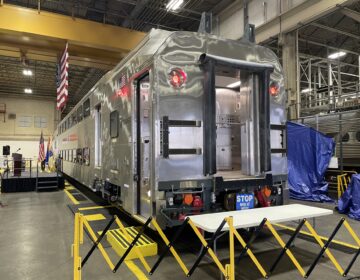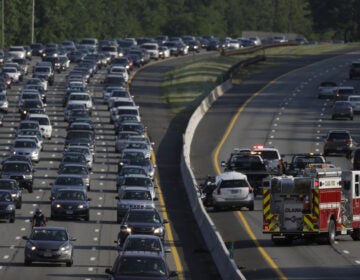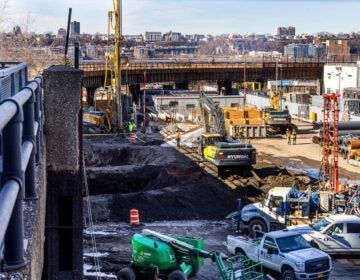Few municipalities in New Jersey will create stormwater utilities, but some should
The need to improve stormwater management is increasing every year. Costs will rise, putting pressure on local government budgets.
- By
- Daniel J. Van Abs, NJ Spotlight August 13, 2018

Metal lid of a channel for rain water (bigstockphoto.com)
The need to improve stormwater management is increasing every year. Costs will rise, putting pressure on local government budgets
-
Daniel J. Van Abs
Once again, the New Jersey Legislature is moving forward with legislation that would allow, but not require, that municipalities and counties establish stormwater utilities, a new approach to funding stormwater management costs. New Jersey is far behind the pack — there are stormwater utilities in 40 states and the District of Columbia, with over 1,600 nationally.
A stormwater utility is a fee-based approach to maintaining and improving public stormwater systems. The purpose is to reduce street and property flooding and to meet federal and state requirements for the control of stormwater pollution and discharge volumes. Nearly every municipality in New Jersey has a municipal stormwater system, and every major suburban and urban area does.
In municipalities with combined sewers, funds from stormwater utilities can be used to reduce the amount of stormwater that goes into the sewer system and then out into our communities and surface waters, without treatment. New Jersey has 21 municipalities with combined sewers, including Newark, Jersey City, Paterson and Camden. They are all subject to stringent regulations from the federal and state government.
All the arguments
As is typical when authorizing legislation of this nature is proposed, and when municipalities or counties propose to establish a stormwater utility, arguments are made in opposition. Some of these arguments have more validity than others. The inevitable result is that the establishment of stormwater utilities is a slow process. After all, while 1,600 stormwater utilities sound like a lot, the U.S. Census Bureau says there are roughly 39,000 municipal and county governments in the United States, and so roughly 4 percent of those have established stormwater utilities. Not exactly a tsunami effect.
Let’s look at the arguments against establishing stormwater utilities one by one to see where the real issues lie.
First, people argue that stormwater is already being managed by municipalities, counties, highway agencies, or private owners. As mentioned by Barry Chalofskyearlier this year in an NJ Spotlight Op-Ed, the truth is that most stormwater systems are either poorly maintained or are repaired only when something goes wrong, such as street flooding. At the local level, public works departments are usually responsible for stormwater systems, among their many functions. Because stormwater systems are subject to minimal state regulation, they get little priority compared to streets, sidewalks, snow plowing and the like. I remember conversations in the 1990s with the New Jersey Department of Transportation and being told that their stormwater system maintenance backlog was enormous. Potholes or stormwater? Guess which gets the priority.
Most people are not aware that the need to improve stormwater management is increasing every year, and that means costs will rise, putting pressure on local government budgets. Federal and state regulations are getting more stringent to mitigate the environmental harm caused by poorly managed or unmanaged stormwater. Most of our stormwater infrastructure was created long before modern standards were imposed. Most of our surface waters are polluted by stormwater discharges; action will be needed to correct this.
Did someone say ‘rain tax’?
Second, the term “rain tax” is often used to make the imposition of stormwater fees sound ridiculous as if we were trying to stop the rain. There are two legitimate responses to this attack. Any part of the rain that doesn’t run off the land (much or most of it) is not stormwater, doesn’t get managed, and isn’t the target of a stormwater fee. Also, taxes are different from fees — a fee is imposed based on the value received, just as for drinking-water delivery or sewer service. A completely natural property generates natural levels of runoff, usually very small, and so isn’t responsible for problems from stormwater. Why should the owner support stormwater costs others have caused?
Third, people argue against the creation of new agencies to manage stormwater. The assumption is that any new utility requires a new agency to run it. What they do not realize is that most stormwater utilities are nothing more than financing methods, and the actual job of stormwater management remains with existing governmental entities such as public works departments and municipal utility authorities that already manage sewer systems. Relatively few new agencies have been formed nationally to implement stormwater management. Why bother setting up something new when an existing agency or department can handle it? What changes is the source of funding for these operations, which changes from property taxes to a fee-based system. It is the routine provision of funds that allows for improved stormwater management. The managers no longer have to guess each year what their revenue will be.
Fourth, people argue that property taxes are an appropriate funding source for stormwater management. Most people don’t recognize that property taxes are a highly inequitable way of funding any water utility — drinking water, sewer or stormwater. A couple of examples will make the point. For one, imagine a one-acre parking lot and a one-acre high-rise apartment building. Both generate the same amount of stormwater, but the apartment building, being much more valuable, will face far higher property taxes. Then, imagine two buildings with the same impervious area, one of which pays property taxes and the other of which is tax-exempt. Both generate the same amount of stormwater, but the first bear the cost burden.
The equity issue is especially a concern when dealing with combined sewers; the parking lot generates no sewerage but a lot of stormwater. If sewer rates are used to fund combined sewer controls, the parking lot pays nothing and residential households pay a lot.
The cost question
Fifth, people argue that the costs of establishing a stormwater utility are too high to justify doing so. Here we hit an issue that has a lot of validity — for some areas. Establishing a stormwater utility is not a trivial process. The municipality or county needs to know and justify why more funds are needed, what the stormwater utility will achieve, who will be subject to the stormwater fee, and how landowners can earn credits for controlling some of their own stormwater. They also need to establish high-quality data on every property to determine equitable and appropriate fees. Many proposed stormwater utilities have been defeated because the local government did a poor job of making the case, leading to public opposition. The lesson from these places is this: If you aren’t going to do it right, don’t even start.
The upshot is that most municipalities in New Jersey will never pursue the creation of a fee-based stormwater utility. And they should not. It doesn’t make sense to create a stormwater utility for a municipality that is largely rural, or where development patterns are very homogenous and nearly all properties are subject to the property tax. Most very small municipalities would not be able to justify putting a stormwater utility in place. In each case, the benefits are outweighed by the difficulties and costs.
No more than 30 to 40 utilities
Assuming that the Legislature passes — and Gov. Murphy signs — legislation authorizing stormwater utilities, where should we expect to see the first ones? I suggest that stormwater utilities will be created first where a municipality or group of municipalities is facing large costs to address stormwater problems that are either stringently regulated, such as combined sewer systems, or that pose some other major local problem. Examples of the latter include stream flooding or erosion that threatens many properties, or pollution of local recreational lakes and streams. In these cases, a strong public argument can be made that the existing approach doesn’t and can’t work, that additional resources are needed, that a major public benefit can be achieved, and that the cost of establishing the fee-based stormwater utility is small relative to the total program costs.
Given that control of combined sewer systems will cost billions of dollars in the next 30 years, it is highly likely that the affected municipalities will be among the first to explore stormwater utility formation. However, the small municipalities with combined sewers are unlikely to consider this approach, unless they band together with other municipalities or a municipal utility authority, due to the complexity of the start-up process.
A regional approach to water pollution control could also work, such as for the improvement of water quality in Lake Hopatcong, Barnegat Bay or the Cooper River in Camden County.
My expectation is that New Jersey will reach the year 2040 with no more than 30 to 40 stormwater utilities, even if authorizing legislation is approved this year. That level would be ample to prove the value of stormwater utilities, to address some critical issues, and to set the stage for further efforts.
—
Daniel J. Van Abs is associate professor of practice for water, society, and environment at the Rutgers School of Environmental and Biological Sciences. He has spent more than 30 years as a professional, manager, and advocate in the fields of water resources and watershed and regional environmental management. With Karen O’Neill, he is co-editor and co-author of “Taking Chances: The Coast After Hurricane Sandy” from Rutgers University Press. The views expressed in this essay are solely those of the author.
WHYY is your source for fact-based, in-depth journalism and information. As a nonprofit organization, we rely on financial support from readers like you. Please give today.
NJ Transit unveils new multi-level, high-tech rail cars
After NJ Transit’s delay-plagued “summer of hell,” the agency unveils new multi-level rail cars to boost customer satisfaction.
6 months ago
New Jersey counties explore new strategies for roadway safety as fatalities rise
Various counties across New Jersey are exploring new strategies to make highways and roadways safer during the busy summer season.
10 months ago
A new $16 billion rail tunnel will connect New Jersey and New York City
The project is expected to be completed in 2034. Here’s what you need to know about it.
12 months ago
Listen 1:18




